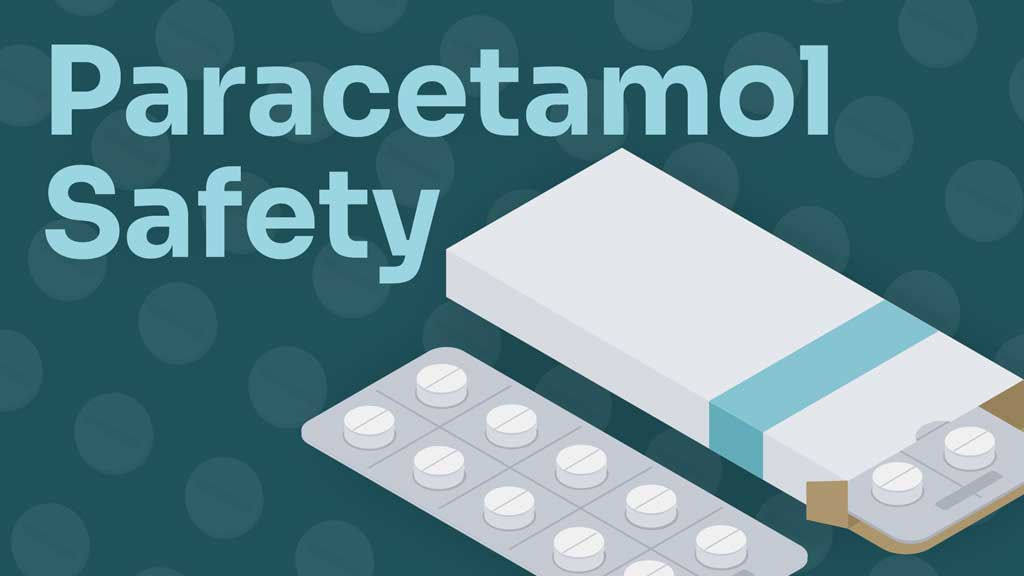Paracetamol is the most commonly used analgesic medicine in Australia (Liotta 2022).
It’s also the most frequently overdosed medicine, the most common reason for calling poisons centres, the top cause of acute liver failure in Western countries, and was responsible for over 95,000 hospitalisations and 200 deaths in Australia between 2007-08 and 2016-17 (Cairns 2019; Cairns et al. 2019).
Every year in Australia, paracetamol overdose is responsible for about 225 liver injury hospitalisations and 50 deaths (TGA 2024).
While paracetamol is considered safe and effective if used as directed, taking more than the recommended dose or overdosing, can be dangerous and in severe cases, fatal (Healthdirect 2023).
With paracetamol being such a widespread and frequently used medicine, it’s crucial for healthcare professionals to be able to understand the potential dangers of paracetamol misuse and recognise and respond to the signs of overdose safely.
What is Paracetamol?
Paracetamol, also known as acetaminophen, is an analgesic medicine used to reduce fever and manage mild to moderate acute or chronic pain. It’s a first-line treatment recommended for pain that can’t be managed using non-pharmacological methods (e.g. rest, ice or heat packs) (Healthdirect 2023; NPS MedicineWise 2019).
Paracetamol is typically preferred to non-steroidal anti-inflammatory drugs (NSAIDs) such as ibuprofen when treating mild to moderate pain as it has less adverse effects (AMH 2025).
Paracetamol may be used to manage a variety of ailments. Examples include:
- Back pain
- Headaches
- Migraine
- Muscle strains
- Menstrual cramps
- Toothache
- Cold or flu symptoms.
(Healthdirect 2023)

Paracetamol comes in a variety of forms, including:
- Tablets
- Capsules
- Liquid
- Suppositories
- Soluble powders.
(ADF 2025)
What’s the Recommended Dose of Paracetamol?
According to the Therapeutic Goods Administration (2019):
| Recommended dose | Maximum amount in one 24-hour period | |
| Adults and children over 12 years | 500 mg to 1 g every four to six hours as required | 4 g |
| Children aged 1 month to 12 years | 15 mg per kilogram of the child’s body weight, every four to six hours as required | Four doses |
When administering paracetamol:
- Always follow the instructions on the label, and
- Do not administer more than one medicine containing paracetamol at the same time.
(TGA 2019)
What is Paracetamol Overdose?
According to the Guidelines for the Management of Paracetamol Poisoning in Australia and New Zealand, paracetamol overdose in adults is characterised by either:
- 10 g (10,000 mg) or 200 mg per kilogram of the person’s body weight (whichever is less) as an acute single ingestion (i.e. any intentional overdose, including staggered or multiple ingestions over more than two hours)
- 12 g (12,000 mg) or 300 mg per kilogram of the person’s body weight (whichever is less) within a 48-hour period, or
- Taking the maximum daily dose per day for more than 48 hours, where the person is also experiencing abdominal pain, nausea or vomiting.
(Chiew et al. 2019)
The Dangers of Paracetamol Overdose
Paracetamol has potentially hepatotoxic properties - that is, it’s capable of causing liver injury or damage (Farrell 2024). This is due to a toxic metabolite known as N-acetyl-p-benzoquinone imine (NAPQI), which forms after paracetamol is administered and can cause damage to liver cells. NAPQI can be detoxified by a substance called glutathione in the liver, however, excessive amounts of paracetamol use up the glutathione stores, allowing NAPQI to accumulate and cause liver damage (Long 2020; Vincent 2024).
This can lead to liver failure, which is potentially fatal (Vincent 2024).
Causes of Paracetamol Overdose and Misuse
Read: Acute Management of Poisoning
Paracetamol overdose may be intentional or accidental (Cairns 2019).
Intentional poisoning, wherein an individual knowingly takes an excessive amount of paracetamol as a form of self-harm, accounts for most (about three-quarters of) paracetamol overdose cases (Cairns 2019).
Accidental overdose may occur for a variety of reasons but is often associated with children finding and ingesting paracetamol in the home (NPS MedicineWise 2019). Other causes of accidental overdose include:
- Assuming it’s safe to take more than the recommended dose due to being able to buy it over the counter
- Taking more than the recommended dose because the desired effect has not been achieved (e.g. the person is still in pain)
- Taking several medicines that contain paracetamol at the same time
- Lack of knowledge about paracetamol and its risks
- Using adult formulations instead of paediatric formulations when treating children.
(Cairns 2019; NPS MedicineWise 2019)

Another contributing factor is the narrow margin between paracetamol’s maximum daily dose and the amount needed to cause overdose (Better Health Channel 2023).
Who Can Take Paracetamol?
As long as it’s used at the recommended dose, paracetamol is safe for:
- Children
- People who are pregnant
- People who are breastfeeding.
(Healthdirect 2023)
People who should seek advice before taking paracetamol include:
- Those with liver or kidney issues
- Those experiencing issues with alcohol
- Those who are very underweight.
(Healthdirect 2023)
Certain medicines may not be safe to take alongside paracetamol as there is the potential for unpredictable reactions. These medicines include:
- Other medicines containing paracetamol, including combination medicines
- Carbamazepine
- Colestyramine
- Imatinib and busulfan
- Ketoconazole
- Lixisenatide
- Metoclopramide
- Phenobarbital, phenytoin and primidone.
(NHS Inform 2024; Healthdirect 2023)
Note: Adults can take paracetamol alongside other analgesics that do not contain paracetamol, including ibuprofen, aspirin and codeine (NHS 2022).
Signs of Paracetamol Overdose
Symptoms of paracetamol overdose often don’t appear until two to three days after the paracetamol was ingested. They might include:
- Drowsiness
- Abdominal pain
- Nausea
- Vomiting
- Seizures
- Coma.
(Better Health Channel 2023)
Note: Side effects of paracetamol are different to overdose symptoms and may include:
- Fatigue
- Rash and itching
- Hypoglycaemia and tremors (in children)
- Feeling hungry, faint or confused (in children)
- Flushing and rapid heartbeat
- Allergic reaction
- Blood disorders.
(ADF 2025; NHS Inform 2024)
Treating Paracetamol Overdose

Paracetamol overdose is a medical emergency. If someone you are caring for is displaying signs of paracetamol overdose, call 000 for an ambulance immediately. If someone has taken more than the recommended dose of paracetamol, even if they appear well and are displaying no symptoms, treatment must be commenced as soon as possible (Better Health Channel 2023).
If in doubt, always contact the national Poisons Information Centre on 131 126.
If the patient is in a critical state, they may require resuscitation, stabilisation and admission to the intensive care unit (Vincent 2024).
Specific management of paracetamol overdose will depend on a number of factors, including:
- The amount ingested
- Whether the formulation is immediate or modified-release
- Whether the ingestion was acute, staggered or repeated supratherapeutic
- The time of ingestion
- The patient’s symptoms.
(Long 2020)
As a very general rule:
- Patients who present early should be administered activated charcoal to prevent the paracetamol from being absorbed
- Patients at risk of hepatotoxicity should be administered the antidote N-Acetyl Cysteine (acetylcysteine) intravenously. If administered within eight hours of paracetamol ingestion, acetylcysteine is 100% effective at preventing liver injury.
(Chiew 2019; Farrell 2024)
Note: This is a very basic overview of treatment for paracetamol overdose. For comprehensive information and advice, refer to the Guidelines for the Management of Paracetamol Poisoning in Australia and New Zealand.
Preventing Paracetamol Overdose
In order to reduce the risk of paracetamol overdose as much as possible:
- Always read and follow the directions on the medicine packaging
- Ensure you use the correct formulation and strength for the patient’s age
- Always measure and take the patient’s body weight into account when administering paracetamol, if indicated (e.g. in the case of children)
- Never exceed the maximum recommended dose
- If administering paracetamol in a liquid form, always ensure you measure accurately
- Document all medicine administered
- Store medicines away from children
- Never administer paracetamol together with other paracetamol-containing medicines.
(NPS MedicineWise 2019)
Changes to Paracetamol Pack Sizes in Australia
As of 1 February 2025, there are new requirements in place for paracetamol pack sizes. This decision was made by the Therapeutic Goods Administration in an effort to reduce the risk of intentional paracetamol overdose. These changes require that:
- Non-pharmacy retailers such as supermarkets, petrol stations and convenience stores may only sell 16-packs of paracetamol tablets or capsules (instead of 20-packs)
- Pharmacies may only sell 100-packs of paracetamol tablets or capsules under the supervision of a pharmacist; without pharmacy supervision, only packs of 50 can be sold (in most jurisdictions).
(TGA 2024)
For further information on these changes, see this article on the TGA’s website.
Conclusion
Paracetamol is extremely useful due to its availability, efficacy and safety when used according to directions. However, while paracetamol is easy to purchase and widely accessible, it’s important not to wrongly assume that there are no risks associated with this medicine.
Paracetamol overdose has caused thousands of hospitalisations and hundreds of deaths in Australia. In order to ensure paracetamol is used safely, it’s crucial to always follow the instructions on the packaging.
Test Your Knowledge
Question 1 of 3
What would be the correct dose of paracetamol for an 8-year-old child who weighs 30 kg?
Topics
Further your knowledge
 Free
Free Free
Free

References
- Alcohol and Drug Foundation 2025, Paracetamol, ADF, viewed 1 April 2025, https://adf.org.au/drug-facts/paracetamol/
- Australian Medicines Handbook 2025, Paracetamol, AMH, viewed 1 April 2025, https://amhonline.amh.net.au/chapters/analgesics/drugs-pain-relief/non-opioid-analgesics/paracetamol
- Better Health Channel 2023, Drug Overdose, Victoria State Government, viewed 1 April 2025, https://www.betterhealth.vic.gov.au/health/healthyliving/drug-overdose
- Cairns, R 2019, ‘Australia Has a Paracetamol Poisoning Problem’, The Conversation, 2 September, viewed 1 April 2025, https://theconversation.com/australia-has-a-paracetamol-poisoning-problem-this-is-what-we-should-be-doing-to-reduce-harm-122532
- Cairns, R, Brown, JA, Wylie, CE et al. 2019, ‘Paracetamol Poisoning-Related Hospital Admissions and Deaths in Australia, 2004–2017’, The Medical Journal of Australia, vol. 211, no. 5, viewed 1 April 2025, https://www.mja.com.au/journal/2019/211/5/paracetamol-poisoning-related-hospital-admissions-and-deaths-australia-2004-2017
- Chiew, AL, Reith, DM, Pomerleau, AC et al. 2019, ‘Updated Guidelines for the Management of Paracetamol Poisoning in Australia and New Zealand - Explanation and Elaboration’, The Medical Journal of Australia, viewed 1 April 2025, https://www.mja.com.au/sites/default/files/issues/212_04/mja250428-sup-0001-Supinfo.pdf
- Farrell, SE 2024, Acetaminophen Toxicity, Medscape, viewed 1 April 2025, https://emedicine.medscape.com/article/820200-overview
- Healthdirect 2023, Paracetamol, Australian Government, viewed 1 April 2025, https://www.healthdirect.gov.au/paracetamol
- Liotta, M 2022, ‘Considerations When Selecting First-Line Analgesics’, newsGP, 27 June, viewed 1 April 2025, https://www1.racgp.org.au/newsgp/clinical/considerations-when-selecting-first-line-analgesic
- Long, N 2020, Paracetamol Toxicity, Life in the Fast Lane, viewed 1 April 2025, https://litfl.com/paracetamol-toxicity/
- National Health Service 2022, Taking Paracetamol for Adults with Other Medicines and Herbal Supplements, NHS, viewed 1 April 2025, https://www.nhs.uk/medicines/paracetamol-for-adults/
- NHS Inform 2024, Paracetamol, NHS Scotland, viewed 1 April 2025, https://www.nhsinform.scot/tests-and-treatments/medicines-and-medical-aids/types-of-medicine/paracetamol
- NPS MedicineWise 2019, ‘Rates of Paracetamol Overdose Continue to Rise in Australia’, NPS MedicineWise News, 29 October, viewed 1 April 2025, https://www.nps.org.au/news/paracetamol-overdoses-rise
- Therapeutic Goods Administration 2019, Recommended Paracetamol Doses, Australian Government, viewed 1 April 2025, https://www.tga.gov.au/community-qa/recommended-paracetamol-doses
- Therapeutic Goods Administration 2024, ‘Comply with Paracetamol Pack Size Changes’, TGA Blog, 5 December, viewed 1 April 2025, https://www.tga.gov.au/news/blog/comply-paracetamol-pack-size-changes
- Vincent, P 2024, Paracetamol Overdose, Patient, viewed 1 April 2025, https://patient.info/treatment-medication/paracetamol-overdose

